In “Preventative Strategies for Lower Back Strains Part I,” we discussed femoral-pelvic and lumbar-pelvic rhythm, muscles that influence these rhythms, and the effects of these muscles on the lumbar spine. Here, our discussion progresses as we cover the trunk, the thoraco-lumbar fascia (TLF), Uddiyana Bandha and how accurate knowledge of this can be used to enhance the benefits of yoga and decrease the risk of lower back strains.
The thoraco-lumbar complex (TLC) is a multilayered structure comprised of the thoracolumbar fascia and the muscles that connect to it. This composition of passive fascial tissues and active muscular structures acts as a corset-like structure that encircles the torso. It plays a key role in maintaining the integrity and stability of the lumbar spine and the sacroiliac joint and is also important for load transfer from the upper limbs to the lower limbs. Engaging the muscles that connect to the thoracolumbar fascia acts to stabilize the spine and trunk. We give an example of this in a previous blog post on using the latissimus dorsi to lift the lumbar and expand the thorax. Figure 1 illustrates the thoraco-lumbar composite in cross section at the mid-lumbar.
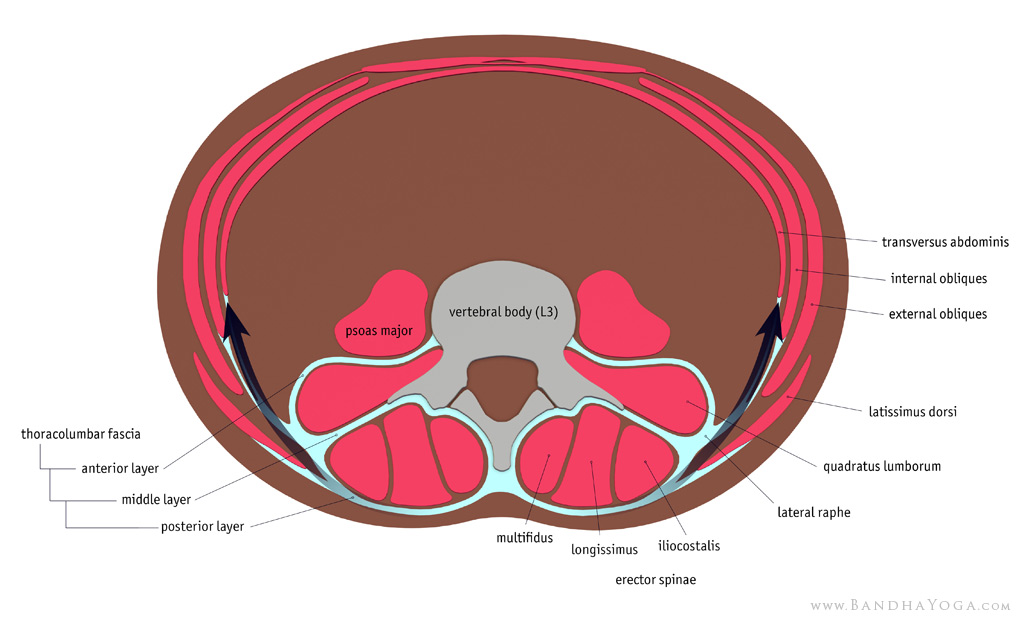 | |
|
To further illustrate, consider a cylindrical container of a fixed volume. Decreasing the circumference of the cylinder results in an increase of its' length (to maintain the total volume). The torso, with the abdominal cavity, can be viewed in the same manner: tensioning the abdominals acts in combination with the TLF to lengthen the torso and lift and stabilize the lumbar. Think of this concept in conjunction with the Sanskrit term “Uddiyana,” which means lifting or flying up. Figure 2 illustrates this.
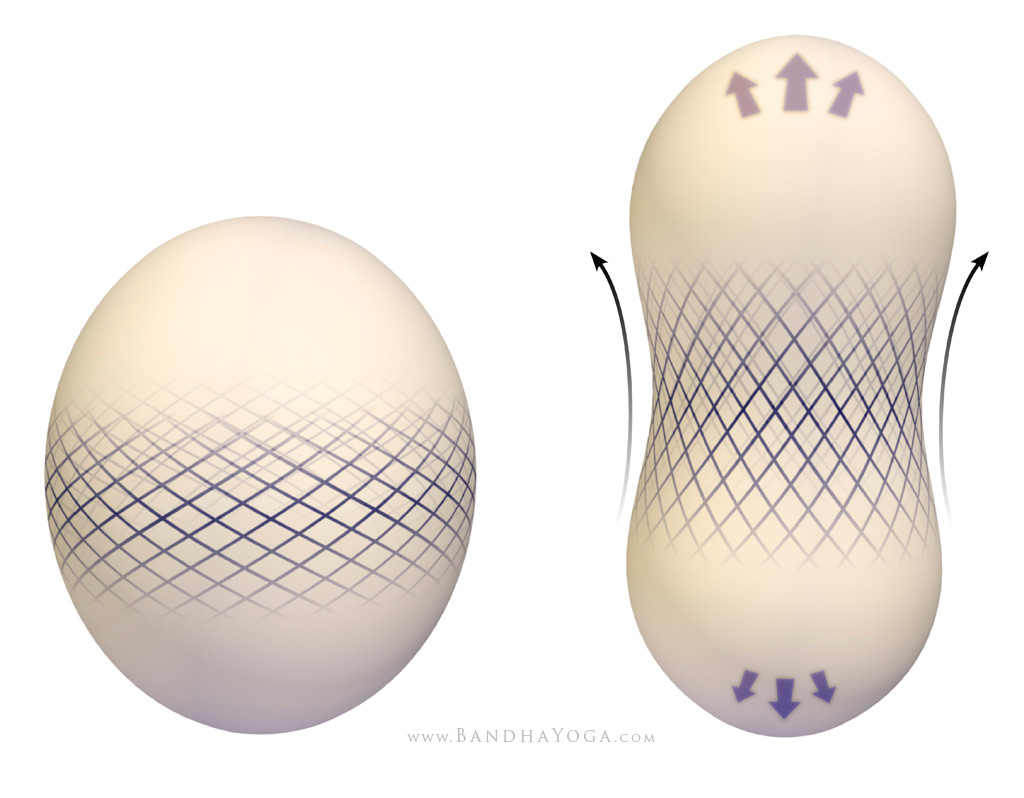 |
| The mechanism for lengthening the trunk with the thoracolumbar complex. The pelvic diaphragm is below and the thoracic diaphragm above. |
This lengthening of the torso takes place through several mechanisms that work in concert to variable degrees depending on the position of the trunk. The first action relates to intra-abdominal pressure (IAP). Engaging the abdominals increases IAP, which numerous scientific studies have indicated stabilizes the lumbar spine. The second mechanism relates to tensioning the TLF. Activating the transversus abdominis muscle tensions the TLF, thereby providing resistance to flexion at the lumbar spine. Furthermore, the transversus abdominis muscle has attachments to the thorax; engaging it transfers stresses from the lumbar region to the thorax and shoulders. Tensioning the TLF also improves the efficiency of the back muscles (surrounded by this fascia) through a mechanism known as the hydraulic amplifier. Because the erector spinae are surrounded by the TLF, its various layers resist muscle expansion during contraction. This tends to straighten the spine (think of how a bicycle tire straightens when you fill it with air). Finally, the erector spinae muscles have fibers that insert onto the interior surface of the TLF so that as they lengthen into a stretch, they can exert a passive pull on the fascia. These various mechanisms contribute to lengthening the torso and stabilizing the lumbar spine. I provide a number of scientific references on this subject below.
Clinical studies have demonstrated an association between low back pain and inefficient engagement of the abdominals. All of this has implications for the use of Uddiyana Bandha, both for protecting against low back strains and for potentially improving the treatment of low back pain through yoga. Below, we illustrate the sequence I use to access this mechanism.
Ease in to awareness of the thoracolumbar composite by using a progression of poses. This leads to understanding of the action of Uddiyana Bandha in lifting and lengthening the trunk and stabilizing the spine. Begin with a pose like simple crossed legs (Sukhasana) or Dandasana. The cue for co-activating the abdominal core and erector spinae is to draw the navel towards the lumbar and lift the lower back. Visualizing the trunk as an hourglass and the anatomy of the thoracolumbar composite as a corset helps to access this lifting and lengthening action. Fixing the hands on the mat and attempting to drag them backwards accentuates this lift by including the latissimus dorsi. Incorporating the accessory muscles of breathing, including the pectoralis minor and serratus anterior, in this pose lifts the lumbar from the thorax. You can experience this lengthening effect by initiating these cues even as you sit reading this post.
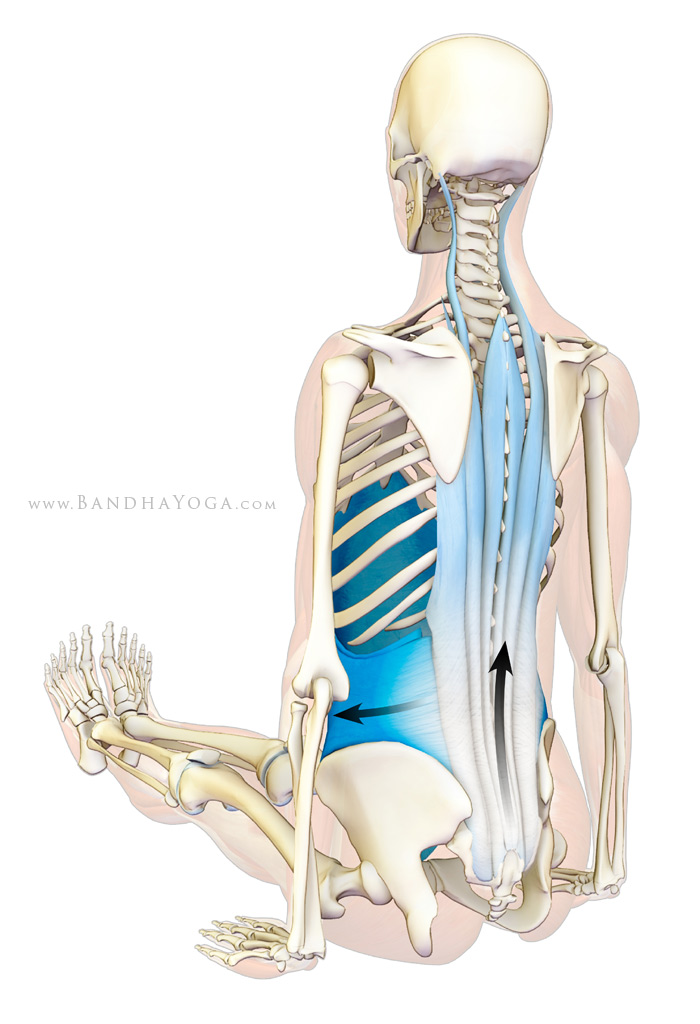 |
| Co-activating the erector spinae and abdominal core to lift the lumbar. |
After warming up, incorporate these same principles into Downward Facing Dog Pose. Engage the thoracolumbar composite by co-activating Uddiyana Bandha and the erector spinae (and quadratus lumborum) to lengthen the trunk and to lift the tailbone, respectively. (Figure 4)
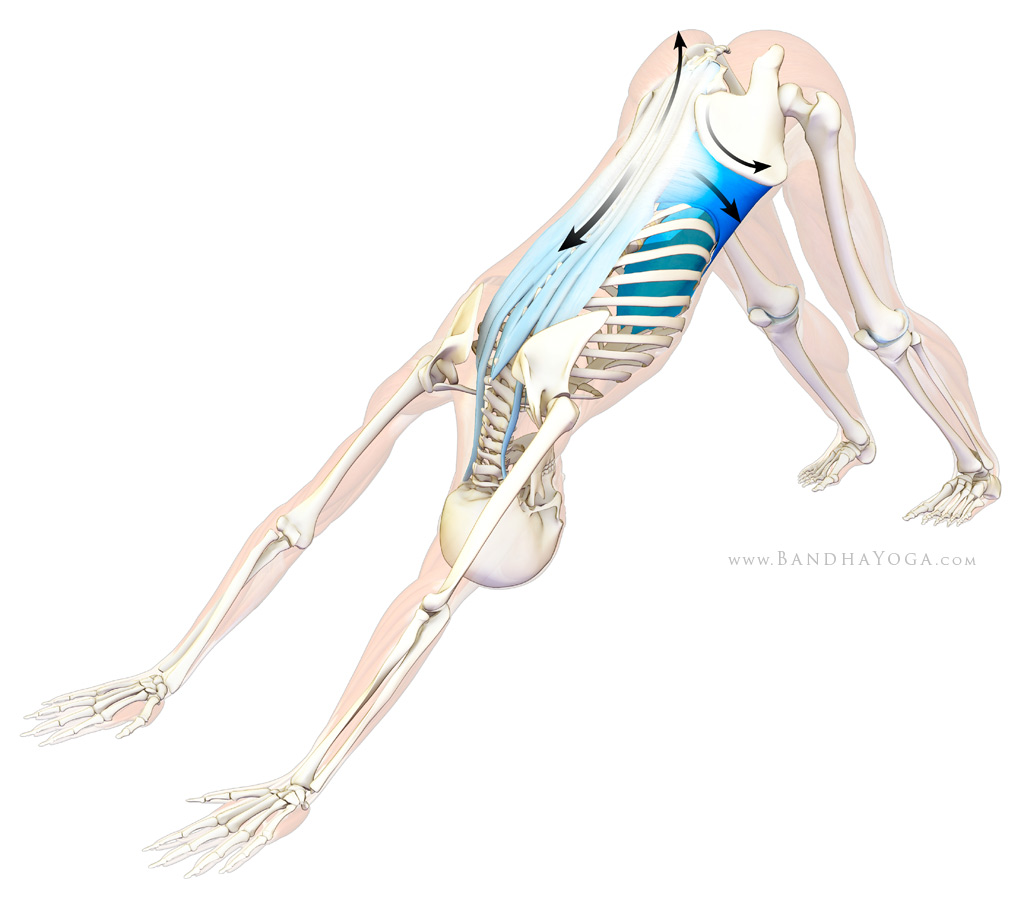 |
| Lifting the coccyx and lengthening the lumbar in Downward Dog Pose. |
These same protective mechanisms can be accessed in forward bends such as Paschimottanasana by using the abdominals to lengthen the trunk, as with the hour-glass visualization described above. Additionally, engaging the abdominal core aids in accessing the function of these poses, which is reflected by their form. Part of this function is to lengthen the muscles of the back. Engaging the abdominal core helps to relax the erector spinae through reciprocal inhibition. Peripheral fibers of the erector spinae attach to the TLF; as these muscles lengthen, their fibers exert a pull on the TLF, thus distributing the forces through the length of the spine. Accordingly, although I may use brief periods of contraction to release the muscle (through PNF), I do not recommend maintaining eccentric contraction of the erector spinae throughout the pose (I will explain why in the next blog post).
I combine the actions of the thoracolumbar complex with lumbar-pelvic rhythm by engaging the muscles that contribute to tilting the pelvis forward. Figure 5 illustrates the connection between the tensor fascia lata, the pelvis, and the thoracolumbar composite. See “Preventative Strategies for Lower Back Strains, Part II” for the cues on engaging the synergists of hip flexion and forward pelvic tilt. Also see our post on co-activating the gluts and abs in Chaturanga Dandasana.
I combine the actions of the thoracolumbar complex with lumbar-pelvic rhythm by engaging the muscles that contribute to tilting the pelvis forward. Figure 5 illustrates the connection between the tensor fascia lata, the pelvis, and the thoracolumbar composite. See “Preventative Strategies for Lower Back Strains, Part II” for the cues on engaging the synergists of hip flexion and forward pelvic tilt. Also see our post on co-activating the gluts and abs in Chaturanga Dandasana.
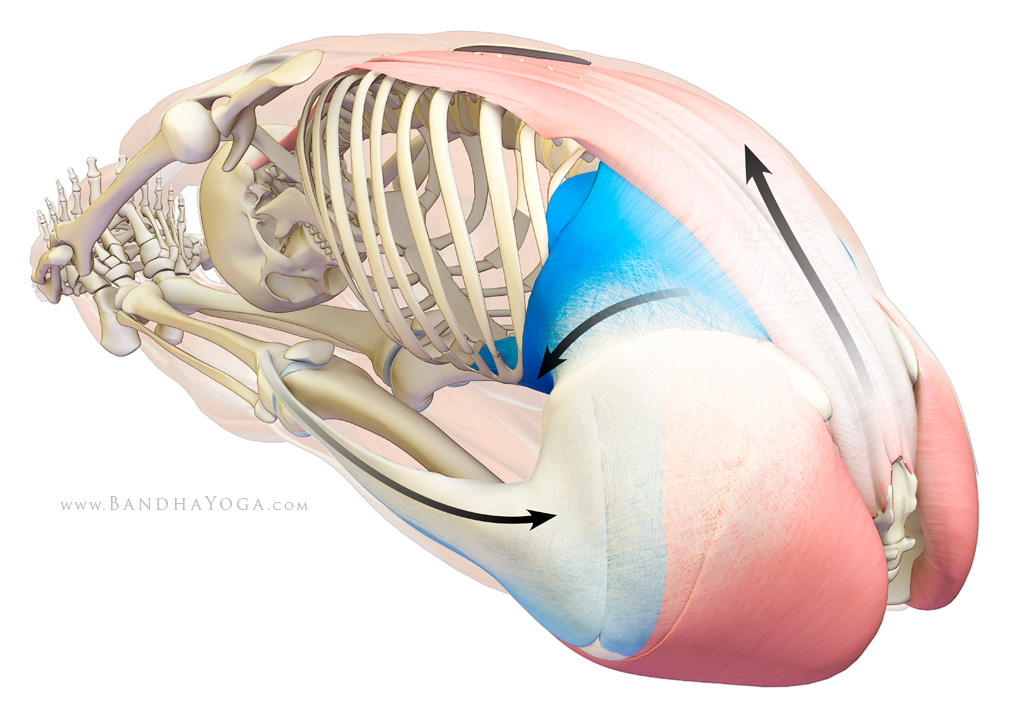 |
| Engaging the TLC with the abdominal core and connecting this to lumbar pelvic rhythm with the tensor fascia lata. |
The anatomy and protective mechanisms of the human body have evolved for eons. These same mechanisms have been researched and documented in the scientific literature. Anatomic and biomechanical principles that govern our bodies when we perform simple actions, such as walking, also apply when we are on the mat. Keeping this in mind, we must dispose of some incorrect concepts permeating the yoga world concerning anatomy and how the body works. The first of these implies that engaging the abdominals and Uddiyana Bandha harms the intervertebral discs. This misinformation, often circulated with graphic descriptions of lumbar disc herniations, discourages engaging the protective and stabilizing mechanisms of the thoraco-lumbar complex in yoga poses under the misguided premise that avoiding these essential mechanisms somehow protects an individual. Other disinformation discourages engaging the abdominal core in forward bends under the odd premise that contracting these muscles causes “congestion”. Finally, there is the breathtakingly false statement that the spine does not depend on muscles for stability. This widely circulated misconception is contradicted by basic anatomy and yoga itself. In this regard, I quote Jiddu Krishnamurti: "Until the false is seen as the false, truth is not."
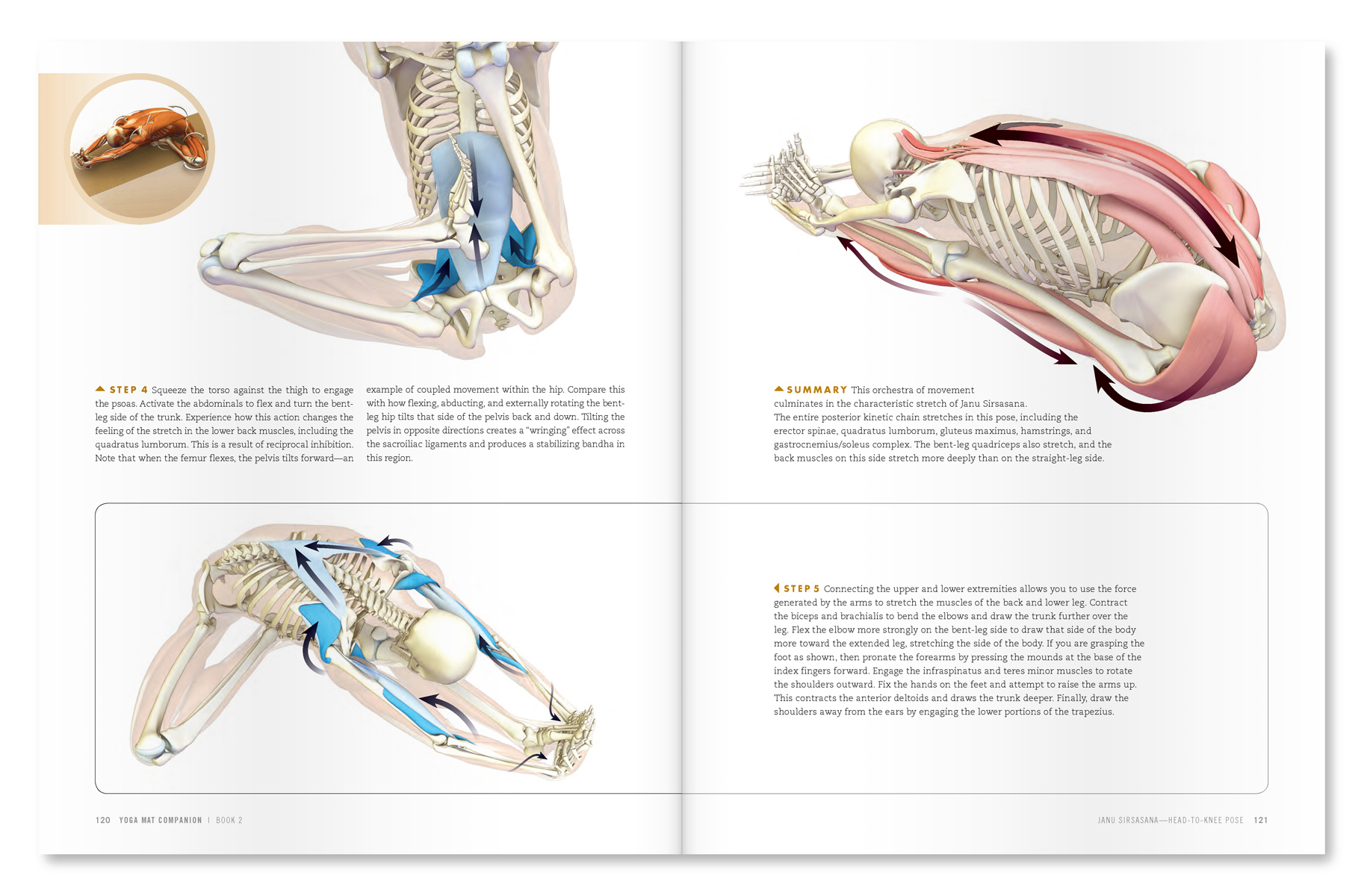 |
| An excerpt from "Yoga Mat Companion 2 - Anatomy for Hip Openers and Forward Bends". |
 |
| An excerpt from "Yoga Mat Companion 4 - Anatomy for Arm Balances and Inversions". |
Good to see you again. Practice under the guidance of a qualified instructor; use their assistance to determine modifications or suitability of a given pose for your individual practice. Always consult your healthcare provider and obtain medical clearance before practicing yoga or any other exercise program.
Check back again for our next blog post where we will go into greater detail on the stabilizing mechanisms of the spine with another protective strategy to aid in preventing lower back strains in yoga. Also, be sure to "like" us on Facebook and download your copy of our free E-book.
References:
1) Hodges PW. “Inefficient muscular stabilization of the lumbar spine associated with low back pain. A motor control evaluation of transversus abdominis.” Spine. Nov 1996; 21(22):2640-60.
2) Crow J, Pizzari T, Buttifant D. “Muscle onset can be improved by therapeutic exercise: a systematic review.” Physical Therapy in Sport. Nov 2011; 12(4):199-209. Epub 2011 Feb 26.
3) Critchley D. “Instructing pelvic floor contraction facilitates transversus abdominis thickness increase during low-abdominal hollowing.” Physiotherapy Research International. 2002; 7(2):65-75.
4) Watanabe S, Kobara K, Ishida H, Eguchi A. “Influence of trunk muscle co-contraction on spinal curvature during sitting cross-legged.” Electromyography and Clinical Neurophysiology. Apr-Jun 2010; 50(3-4):187-92.
5) Essendrop M, Andersen TB, Schibye B. “Increase in spinal stability obtained at levels of intra-abdominal pressure and back muscle activity realistic to work situations.” Applied Ergonomics. Sep 2002; 33(5):471-6.
6) Cholewicki J, Panjabi MM, Khachatryan "A Stabilizing function of trunk flexor-extensor muscles around a neutral spine posture." Spine. Oct 1997; 22(19):2207-12.
7) Unsgaard-Tøndel M, Lund Nilsen TI, Magnussen J, Vasseljen O. “Is activation of transversus abdominis and obliquus internus abdominis associated with long-term changes in chronic low back pain?" A prospective study with one-year follow-up. British Journal of Sports Medicine. Jul 2011; 26. [Epub ahead of print]
8) Hodges PW, Richardson CA. “Delayed postural contraction of transversus abdominis in low back pain associated with movement of the lower limb.” Journal of Spinal Disorders and Techniques. Feb 1998; 11(1):46-56.
9) Bjerkefors A, Ekblom MM, Josefsson K, Thorstensson A. “Deep and superficial abdominal muscle activation during trunk stabilization exercises with and without instruction to hollow.” Manual Therapy. Oct 2010; 15(5):502-7. Epub 2010 Jun 8.
10) Hodges PW, Cresswell AG, Daggfeldt K, Thorstensson A. “In vivo measurement of the effect of intra-abdominal pressure on the human spine.” Journal of Biomechanics. Mar 2001; 34(3):347-53.
11) Hodges PW, Eriksson AE, Shirley D, Gandevia SC. “Intra-abdominal pressure increases stiffness of the lumbar spine.” Journal of Biomechanics. Sep 2005; 38(9):1873-80.
12) Barker PJ, Guggenheimer KT, Grkovic I, Briggs CA, Jones DC, Thomas CD, Hodges PW. “Effects of tensioning the lumbar fasciae on segmental stiffness during flexion and extension: Young Investigator Award winner.” Spine. Feb 2006; 31(4):397-405.

Good to see you back ! It's been a long time.
ReplyDeleteI like very much the injury prevention subject. You've already disseminate some of it in your books (I remember the air bag effect or the rotator cuff analysis). Maybe the subject of a new book ?
Your work continue to amaze me ! Keep going !
Yann
Hello Yann, Thanks for commenting. I'm working on that very subject now--coming soon. Best~Ray
DeleteHi Ray and Chris,
ReplyDeleteYour blog is great, always a highly analytical and illustrative way of adding more intelligence to the various poses. Now, if I could only do them...! :-)
Dan
Thank you, Dan. Much appreciated--keep workin' at the poses! Ray
DeleteThank you Ray... it's the best explanation I've ever read!
DeleteRay, Very well explained! Thank you for sending your 'dailybandha'. I'm not a yoga teacher, but practice yoga every day and I'm so inspired by your work.
ReplyDeleteSimone
Thank you, Simone--much appreciated! Ray
DeleteThanks Ann-great to see your comment. Namaste'~Ray
ReplyDeleteIntelligence and mastery written in way that heightens my own intelligence. Visualization while reading.....I understand and now can apply. Thank you.
ReplyDeleteThank you, Ana-much appreciated~Ray
DeleteI love the information you provide. It translates the complexities of being able to move safely throughout various yoga poses and being able to understand what is going on as a result. Thank you for such a valuable contribution to a yoga practice.
ReplyDeleteGreat to hear, Yogashar! Ray
DeleteSOOOO glad to see this new post! Gave me some new cues for a student I have with some edgy lower back issues, and validated some techniques I've been using. THANKS! Very much looking forward to the next post.
ReplyDeleteNamaste! ~Diane
Thank you, Diane--much appreciate your comment. More to follow on this subject soon. Namaste'~ Ray
DeleteAfter all the misinformation on the media you give us yogis and yoginis a good name :)Thank you for making me a better teacher each day. I have incorporated your asanas on my orlando Yoga Teacher page, for all to see. From the first time I picked one of your books I fell in love with your work. Any suggestions or thoughts on headstands?
ReplyDeleteThanks--will be speaking on inversions soon. In regards to my thoughts on the media misinfo, you ain't seen nothin' yet...
DeleteI can see you address the misinformation on your latest blog, this is great I have a student with a bad case of fear due to DDD and some disk herniation. I was told by another teacher to avoid him doing the foward folds, however after talking to my student he reveal it actually helps him. I opted to listed to my student. Thank you for clearing it up. What are your thoughts on asanas to help aliviate the pain down his leg? if anything?
ReplyDeleteYoga is most important for human body. I am very pleased to know that Uddiyana Bandha and how accurate knowledge of this can be used to enhance the benefits of yoga and decrease the risk of lower back strains. Yoga can protect many diseases in our body. I think that every person should take Yoga regularly. Then we will get lots of facilities for this. Thanks for your nice post.
ReplyDeletehow to build your muscles
Hi Ray!
ReplyDeleteI wanted to get in touch and thank you for the amazing workshop at the yoga conference today... I am now checking out your blog and am looking forward to seeing your future posts. I am combining psychotherapy with yoga therapy and appreciate the care and gentle approach you have and the opportunity to rethink the approaches we have been taught and to use our own analysis to play with the poses. Would love to chat with you about therapeutics and hope to train with you again soon!
Melissa Pearson
Hi Melissa,
DeleteDelighted to hear that you enjoyed the workshop--great to have you attend! Let me know what you are working with in the therapeutics. I think there is a big place for yoga in your work.
Best~Ray
Thanks for your post Ray. I have worked on my own situation for over 30 years and teach Yoga. The clarity and user-friendliness of this message is outstanding. :)
ReplyDeleteYoga prevent and improve our health and prevent before diseases.
ReplyDeletePrepare the forward bends by building back muscles and stretching the leg muscles first. Forward bends will be easier and safer when we have all legs and back muscles available beforehand. I got trained by Herve at Satyam in Montreal. He has broken all misconceptions and taught us the right and safer way to build a stronger body that allows us to stay sit comfortably for hours in meditation or in Tadasana for hours.
ReplyDeleteAwesome thanks ray
ReplyDelete